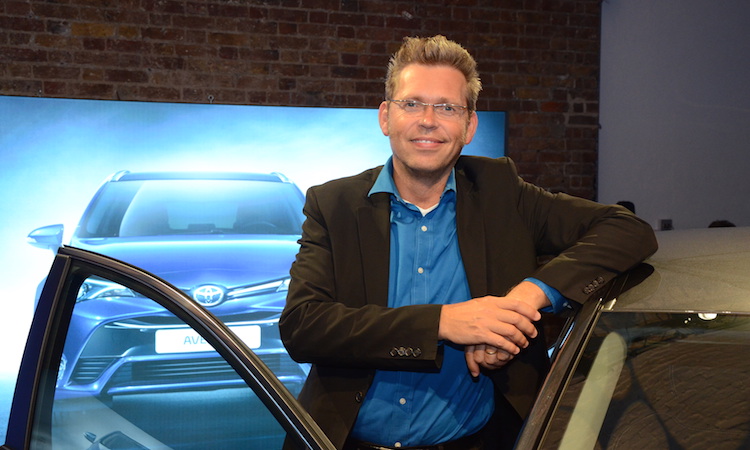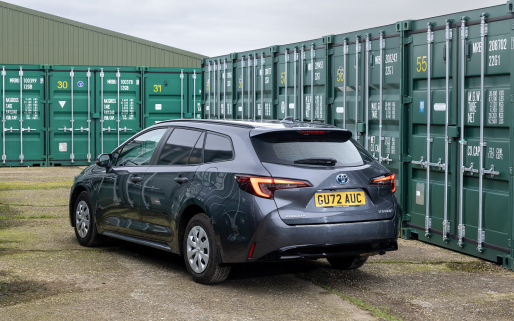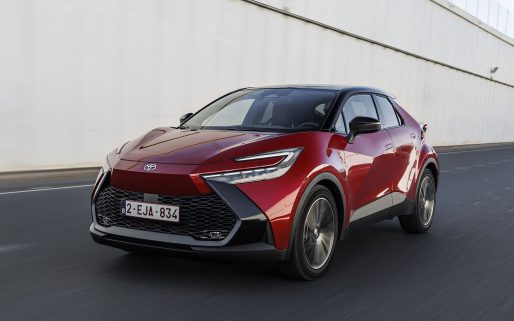At a recent preview event for the upcoming new Toyota Auris and Toyota Avensis models, we caught up with one of the people behind one of the cars’ key new features, Toyota Safety Sense.
A new package that will be available as standard or as a reasonably priced optional extra across 70 per cent of the Toyota range by the end of 2015, Toyota Safety Sense brings together features including pre-collision detection, lane-departure warning, automatic high beam adjustment and road sign assistance to make driving safer.
We spoke to Tjark Kreuzinger, Senior Manager of Safety Research & Technical Affairs at Toyota Motor Europe, to find out more about the system, the tech behind it and where it could lead.
Toyota Blog: Hi Tjark. How long have you been working on Toyota Safety Sense?
Tjark Kreuzinger: Pretty much four years. What we had before was the pre-crash safety system (which we now call pre-collision system). It’s still in production and is based on long-range radar, or on some models, radar and cameras. It’s very good, but expensive.
The challenge we had with Toyota Safety Sense was to make that capability more accessible and easy to adopt for more people. We wanted to bring everything together in one unit, and that’s where Toyota Safety Sense came from.
TB: So what is the Toyota Safety Sense unit?
TK: It’s one unit, mounted to the windscreen, which has lidar – a laser system – and a camera, so two sensors. It works at speeds up to 50mph, much more than what you’d normally expect from the ‘city’ systems that have been around up to now.
Toyota Safety Sense can fully avoid impacts at a driving speed of 30kph (18.6mph) in basically every situation. But depending on the conditions, for example in a potential car-to-car collision, where the car ahead is driving at a similar pace to the one behind, it can work at much higher speeds like 80kph (50mph).
The system is also good for giving a very accurate detection of what kind of obstacle is ahead – it does not just recognise there is something in your path, but it also classifies it.
TB: How does it do that?
TK: The best explanation would be to say that if you only have a camera, you cannot distinguish between a cardboard cutout of a person, and a real person. If there is a cardboard cutout next to the road, a camera-only system would not be able to tell if it is a human or not.
A radar-only system would not work perfectly either because it’s actually hard to distinguish between a human and something like an aluminium can because of the reflection it receives back is too similar, and it only scans horizontally so it is not as sensitive to the position of an object.
When we can use radar and a camera as well, we can make the sliding scale between activation and non-activation more accurate. A human doesn’t actually create much of a lidar or radar response, but it has a bit – and significantly more than a piece of cardboard or some other object. Combining the lidar input and the camera, the system can know very well if it’s seeing a human or not, where the human is, and then decide whether to activate the safety system.
A fusion of these technologies can deliver higher performance and better avoid any false detection.
TB: Are there additional sensors around the car?
TK: It’s just the one unit, it combines the lidar and camera. The idea behind Toyota Safety Sense is to use multiple technologies within one unit in order to make an accurate system that is accessible to more car owners and not too expensive.
TB: Will the Toyota Safety Sense system immediately take control of the car if it senses a potential accident?
TK: We know that accidents happen because drivers are not perfect. Around 90 per cent of accidents are due to driver error. This means that a driver might not detect what’s going on around them, might not react properly, or not react at all. And as a consequence accidents still happen.
One of the key Toyota philosophies is to try and inform the driver as much as possible, making them alert so they can react to a situation. We’re not trying to completely automate the system.
Our studies have shown that three-quarters to 80 per cent of people will react in a potential accident situation if they’re given a warning. So having the car ‘prepare’ itself by boosting brake pressure, while giving the driver the opportunity to react on their own is the preferred solution at this stage – we like to have the driver in control.
Of course, if the driver does not do anything to react, then the automated element of the system takes action.
The technology of our new system and the reason it’s better at detection is to give drivers more warning of possible collisions, enough for them to act and prevent a collision at higher speeds.
TB: Automated driving is a hot topic at the moment. It sounds like Toyota Safety Sense keeps the driver at the centre of what’s going on.
TK: We appreciate the technology that automated driving is connected to, because it will increase road safety. We support making more safety systems available, for example what we have here, but Toyota Safety Sense is not automated driving.
That said, it is pretty well-known that Toyota is working on automated driving systems, and especially here in Europe as there is a big push from governments and cities to make roads safe, while dealing with environmental issues and increasing traffic density.
There are definite theoretical benefits to automated driving. Once cars can talk to each other, systems will even allow for detecting problems that are around the corner, out of sight in a city condition or in a traffic jam. In Japan, Toyota is already operating a couple of cars in real traffic in order to investigate this.
We think automated driving will happen. We think customers will like it, but we do not aim for automated driving because we simply think it would be interesting – it’s the safety behind it that appeals to us and there is lot that can be done while keep the driver at the centre of things.
TB: Some features of Toyota Safety Sense give additional benefits during normal driving, such as adaptive cruise control. Do those ‘extras’ make pitching your ideas easier?
TK: Absolutely. For my colleagues, safety is the number one priority but we recognise the fact that sensors and technology developed for safety purposes can provide a driver with good information and convenience.
It’s a part of what we call the integrated approach. For example, if you have radar systems that help when you’re parking and let you know the position of your car is OK, then you have more mental resources to watch out for pedestrians appearing behind you.
When you’re in normal driving, support systems such as braking stability control, adaptive cruise control or anything like that, allow you to have better control of your inputs and your car. They help avoid accidents – stability control is a good example as it reduces single-car accidents by 40 per cent – and when you get closer to risk, the systems like Toyota Safety Sense allow the driver to get more information, earlier, before an accident could happen.
Obviously we still always focus on the passive safety of Toyota vehicles to protect occupants when a collision is unavoidable, but the next stage for my team is working on the systems to improve and speed up the rescue of people who have been in an accident.
TB: Will new features be added to Toyota Safety Sense as time goes on?
TK: We are launching the system now, and we think it has great benefits and we are pleased it will be very accessible to people – either as a standard feature or an option that is reasonably priced depending on which model someone chooses.
That said, we are not at the end of what pre-collision safety can do, so over time we are certainly aiming to continue pushing things forward. Anybody might be able to imagine what that might be – for us, that would be wider-range sensors, or additional sensors to create more of an all-around view.
Find out more about Toyota Safety Sense at Toyota.co.uk or in this blog post.





I have this in my new Auris! There’s a problem in that condensation is forming within the sensor housing, preventing the system working, especially the auto headlamp beam function. Comment please!
Hi John,
Thank you for your post. We have spoken with our technical team and they have advised you visit your local Toyota Dealer. You can find your local dealer here: https://www.toyota.co.uk/world-of-toyota/find-your-dealer.json. Many thanks.
I’ve got the same problem. The car is fine but the safety sense system is a real pain.
The ‘fix’ might improve things a bit. System still fails in rain or ice!
We have a car with the same issue, The heat pad repair worked during the summer, but has failed again in Nov / Dec 2016 with the cold weather. I did mention to Toyota that the heat pad would not work, and was a rush job to sort out a fundamental design flaw in the positioning of the sensor cluster. The problem with being unable to return the lights to main beam when in auto is just dangerous in the countryside.
We also had issues with the electronic handbrake and issues with the exhaust gas recirculation valve in the engine and the vehicle is back with the main dealers for maybe 10days.
Now very good from Toyota.
I am having the same issue with my 2015 Avensis
Hello Ged,
Thank you for your post today. We have passed this by our technical team and they have advised you visit your local Toyota Dealer. Your local Toyota Dealer can be found here: https://www.toyota.co.uk/world-of-toyota/find-your-dealer.json. Many thanks.
I’m glad I’m not alone in this then Ged ! I’ll be very interested to hear how you get on with this. It’s a real pain and I cannot always replicate it on my Auris. Cheers John
January 2016 My March2016 Avenisis has been having major issues with the SafetySense systems as described above (I believe).
Even the day after the addition of the heat pad in December 2016, It continues to disable itself and I get the full panoply of warning lights and messages. I was advised to keep a log – this shows that the “events” only happen at night and NOT when its raining.
The car is currently at the dealer (Somerset County Cars, Taunton) and I have been advised by their Tech that Toyota guidance is for the heater to be constantly on, constantly set to 22 degrees, constantly pointed at the screen and to have aircon constantly on. This is patently ludicrous advice and renders the heating system unfit for purpose of heating the car and the passengers and seems to be a panic measure given I am reliably told by a Toyot salesperson that this problem effects most of the 2016 cars on the road fitted with the safety sense system.
If Toyota is unable to fix this problem they will be hearing from my lawyers, meanwhile BBC’s Watchdog, all of the motoring press and all of the national press will be hearing an awful lot of noise from me.
Hi Martin,
Thank you for getting in touch with us and we’re so sorry to hear you’re having difficulty with your vehicle. We’re glad you’ve taken your vehicle to your local Toyota Centre and they should be able to help you with this issue. Have you logged your complaints with Toyota’s customer service team?
Hi there – no I logged them with Toyota’s CEO directly. I also asked for softweare to be delevoped to switch off the darn warning lights and messages until a proper fix is found. They’re far too distracting, especially at night…..
Hello Martin,
My 2016 Auris Excel 1.8 Hybrid Touring Sports + Pan Roof + TSS has the same issues with the TSS sensors as described by you and others in this blog. The problem has become a daily issue during the current spell of overnight frosty weather. Yes, the various warnings associated with the failure of the TSS system are a major distraction when driving and also nullify the safety features that were a major factor when I decided to buy the car. I am both surprised and disappointed that Toyota sell a vehicle with this TSS system that is so clearly unfit for purpose.
I intend to badger my dealer until something is done to rectify this dangerous and annoying problem.
I am now 100% fed up with my 2016 Auris Hybrid Touring Sport (with TSS) with regard to the Touch and Go and TSS system problems.
– Inability to play music from USB stick (worked perfectly well with 2014 model!!)
– Poor quality maps
– S-L-O-W response
– Intermittent TSS failures – even near end of a journey, so I don’t think due to condensation. To get main beam back I have to switch lights to manual, not ideal when on a darkened stretch of road!!
I’ve logged a complaint with Toyota, got the usual unsatisfactory reply of “contact your dealer”. Have requested a callback from someone technical.
Now planning to reject the car as is is still less than 6 months old. Shame really as the car itself is quite nice…
Never again!
Hi Ian,
We would have to suggest waiting for a response from your local dealer to see what they advise. If you do not get a satisfactory response, we would suggest contacting customer relations again to see if they can help. Many thanks.
Although we reported the problem soon after taking delivery of my wife’s Auris last January we only discovered this fix has been available all along when taking it to another dealer for it’s first service. Many people suffering the problem – see Toyota Owners Club forum (which also indicates the “fix” often doesn’t work). The issue renders the TSS system inoperative, but Toyota are not seeing fit to issue a recall.
I won’t touch another Toyota due their indifferent approach on this and the Touch 2 system commented upon elsewhere. In fact because of this I replaced my own car last Autumn with a Mazda 6 (no issues) when an Avensis would have been in the running.Well done again Toyota
Hi Ella,
Local dealer in East Kilbride informed me that Technical Service Bulletin for TSS now issued (as of 23rd January). Consists of fitting a heater to the sensor housing and software change. Not sure if fitting a heater will work since I was told the sensor housing is sealed..
Car is booked in for end January, so will feedback result.
(Different blog, but since I mentioned it above, infotainment software update 6.8.2WH seems to have fixed problem playing MP3 music from USB stick..)
Hi Ian,
Thanks for the update. We hope this issue gets resolved for you and do let us know if there is anything else we can do. Many thanks!
Hi Ella,
Car was left with Toyota dealer in East Kilbride today (31st Jan) to perform the TSS improvements/modifications as per recent Technical Service Bulletin.. I got a call in the afternoon to inform me the TSS calibration would not complete successfully and that a new camera module would be required. I believe this is the first TSB to be attempted by local dealer. Wasn’t happy about driving the car in this state and requested a replacement vehicle until my Auris Hybrid TS back in working order. Imagine my delight to be provided with an Aygo courtesy car.. So in response to your question above, what CAN you do? I feel that owners like myself are being treated as guinea pigs in debugging Toyota’s systems problems! I look forward to your response!
Hi Ian,
All we can advise is to contact customer relations with your issue. They will be able to assist with your query. We’re happy to pass on your email address and name if that would be useful to you? Many thanks.
“Consists of fitting a heater to the sensor housing and software change”
Sorry to tell you that this did not work for my Avensis. The warnings are still happening at night in cold weather
Hi Martin,
I have to report that I’ve not experienced any genuine TSS failures since early February 2017.
Recap, my car would not re-calibrate after the TSS TSB modification (heater pad fitted). I was told that the fault code indicated a defective camera module. A new camera module was ordered and fitted. Since then, I have driven through snow/hail/rain/sunshine weather conditions and system has performed faultlessly.
BTW, I think the “software” update I mentioned as part of the TSB is just re-flashing new calibration data, rather than altering how the TSS software functions.
Hi Ian, that’s really good to hear. My camera failed on day 2 of my ownership on March 2nd 2016 and I guess I was one of the first in the Uk to have a new one fitted (not something to be proud of !)
My system has continued to error into early March but to be honest I didn’t drive the Avensis much at night (when the vast majority of problems ocurred). As I expected, with the warmer, drier, weather (here in Somerset) – and little chance of condensation – I haven’t had a recurrance in the last 3 weeks night or day.
(I have, incidentally, been wondering if the problem was with condenation on the laser itself or the camera lens rather than the windscreen inside the pod, but guess we’ll never know).
From my perspective I now have a problem. As condensation is unlikely until (say) next October, do I assume the problem with the system is now cured or is it merely being masked by the lack of conditions in which condenation arises?
I’ve all but decided that I can’t take a chance that the problem is still lurking within the system and don’t want to wait 6 months to find out it is, so I’ve opened negotiations with my dealer for a big discount on a C-HR (which uses RADAR) and I also have a meeting later this week with Toyota GB’s head of quality (Greg Culshaw) so we’ll see where that goes.
Following the discussion of faulty safety sense with interest. My 2016 Avensis has the problem and the “heater” fix doesn’t work. I think Toyota will only sort this out after they have been sued for damages for an accident where this design fault played a part. If anyone is wiiling to organise a class action I would be interested in joining it
Hi Patrick,
We have spoken with our customer relations team about these issues and we would like to take your registration number of the vehicle and your email address. Please could your provide us with these details and customer relations will be in touch. Many thanks.
Hi Martin,
Thanks for getting in touch. We can see that you have a case open with customer relations, your situation is currently being investigated and they will be in touch very soon. Many thanks.